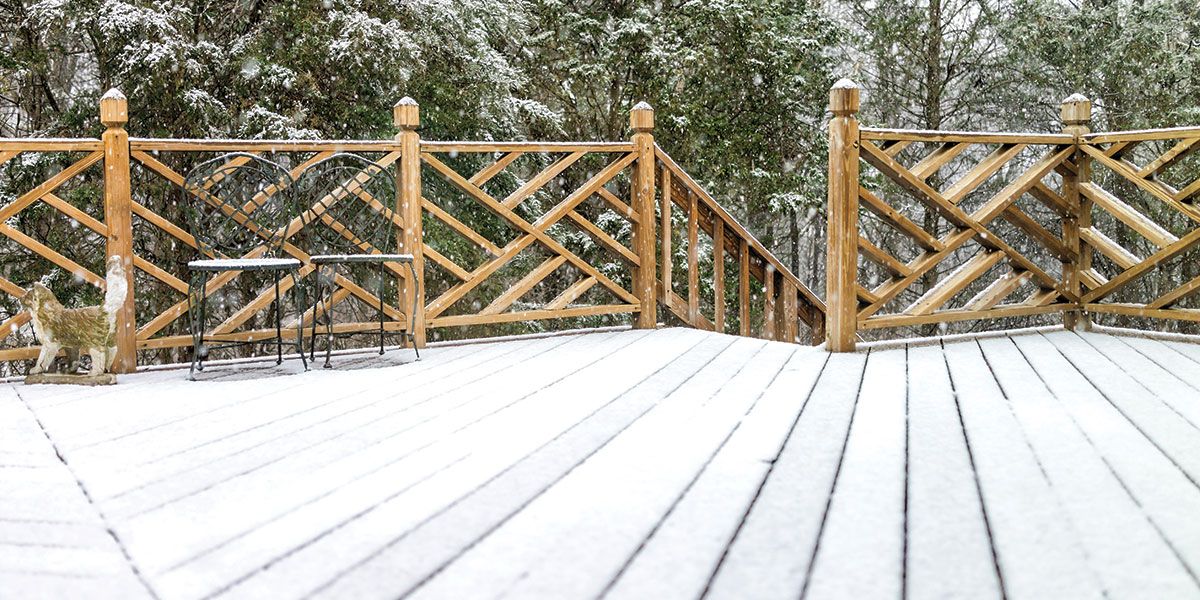WINTERIZE YOUR WALKWAYS

Protect Your Patio, Sidewalk, Deck & Porch this Winter Season
Virginia winter weather can really pack a punch for your home’s outdoor living areas. Before you know it, your beautiful porch, deck and walkways can start to lose their radiance and may begin to show signs of erosion due to snow and ice.
The best way to avoid these issues is to take the time to properly care for and winterize your outdoor spaces before the frigid temperatures set in for the season. Here are several ways to ensure your stone and wood surfaces are ready to face the winter ahead.
 Thorough inspection
Thorough inspection
For starters, it’s important to do a thorough inspection of your outdoor hard surfaces. Remove all outdoor furniture, pots and planters from your deck, porch or walkways so you have an unobstructed view of the space. Look for any signs of wood rot, broken stones, mold, mildew or loose nails and screws. Store all furnishings and planters away for the winter season, as these things provide places for mold and mildew to grow where dampness accumulates.
If you come across any damage that is a quick and easy fix, now is the time to do so. This will help with upkeep and make winterizing your outdoor spaces less of a hassle.
One area to check is your drainage. According to Southern Landscape Group President Mark Maslow, it is vital to make sure you have proper drainage that flows off and away from outdoor features.
“Make sure your yard drains, surface drains and gutter downspout lines are free and clear, so water does not puddle up,” Maslow said. “Excessive water puddling mixed with sub-freezing temps are not good for your surfaces and over time may cause damage to them.”
After you have attended to any minor damage on your outdoor hard surfaces and addressed things such as drainage, it’s time to do a clean sweep of these areas as well.
Clean is key
It’s important to clean up any debris lingering on your walkway, porch or deck. If left alone, debris will break down into organic matter that can then rest in the cracks, crevices and spaces between stones, causing issues such as weeds. “By keeping your patio/walkways free of this debris, you naturally prevent weeds from growing,” Maslow said.
You can use an outdoor specific broom or leaf blower once a week to whisk away any leaves, branches or dirt that may have accumulated in corners and under deck furniture.
One reason natural stone is so popular is because maintenance is minimal to none, says Maslow. “Typically, natural stone surfaces like bluestone, sandstone and limestone do not need any maintenance other than light pressure washing periodically,” Maslow said. If you do elect to pressure wash, just do so without using too much pressure, as this can cause damage to stone and wood.
Once you’ve gotten the maintenance and cleaning side of things taken care of, you can shift your focus to winterizing your space to make sure things are good to go in case of snow, rain and ice.
To seal or not to seal?
Before you begin sealing, it’s important to know the proper care techniques for different outdoor materials, such as stone, concrete and wood.
Sealing stones for the harsh winter weather isn’t usually necessary, unless they are used in a mortared application. “The sealer helps protect the mortared (often called grouted) joints from failing prematurely,” Maslow said. “Heavy freeze/ thaw actions and standing water will cause more problems if the stone is not properly protected.”
When it comes to wooden decks, Maslow says it’s great to seal them with a high-quality proven sealer such as Sikkens. Maslow notes that when sealing your wooden deck, it’s important to clean it well and let it dry completely first. “This allows the wood to soak up the sealer properly,” Maslow said.
Snow, ice and freezing rain
When the frigid temperatures pose the possibility of winter precipitation, it can be tempting to reach for salts. But rock salts can actually be extremely damaging and corrosive to your outdoor stone and wood surfaces.
Maslow strongly discourages the use of rock salt on any other hard surface besides asphalt. Instead, he recommends using a calcium or magnesium chloride de-icing product, which is safer for hard surfaces. And whenever possible, Maslow encourages letting Mother Nature do her thing to melt the ice and snow naturally.
When clearing your hardscape surfaces, it’s important to use a plastic shovel so as not to damage your walkway and deck. Using a metal shovel poses the risk of scaring your stone and splintering your wood.
But with the proper care and upkeep of your hardscape surfaces, you can stay one step ahead of the snow and ice this winter season. With a bit of time and effort your outdoor surfaces will be winterized and prepared for the harsh weather ahead! ✦
deck, freezing rain, frigid temperatures, gutter downspout, hard surfaces, ice, natural stone, outdoor spaces, porch, sealer, snow, surface drains, Walkways, winterize









